
|
GREATEST FILM SCENES 1970s - 1990s |
| Film Title/Year and Film Scene Description | |||||||
|
# 85. Patton (1970) George C. Scott's towering portrayal of the obsessive, arrogant, colorful, heroic World War II general begins with his classic, six-minute monologue about Americans and their fighting spirit. This was the role and performance for which Scott was given an Academy Award that he declined and refused to accept. The opening scene featuring the larger-than-life, egotistical, much-decorated general is set before the backdrop of a huge American flag. After the anthem concludes, he ends his salute and with a cold, mean look, delivers his speech to offscreen troops, peppering it with numerous profanities. He praises those who would fight, promising potential glory for his soldiers:
|
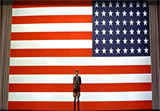 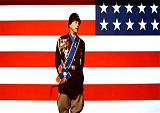 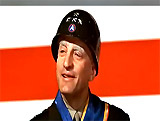 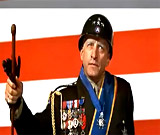 
|
||||||
|
# 86. A Clockwork Orange (1971) One of the most controversial of all of Kubrick's films is his ultra-violent, over-indulgent, graphic film of the near future - its sadistic scene of a rape coupled with song and dance from one of Hollywood's most famous musicals is particularly sensational and perverse. An ebullient young punker Alex de Large (Malcolm McDowell), wearing a bowler hat and one false eyelash (upper and lower), joins with other teen-aged "droogs" to engage in a night of sado-sexual escapades (beatings, pillaging, mayhem, break-ins and rape). At the ultra-modern residence of the Alexanders (Patrick Magee and Adrienne Corri), the elderly writer and his red pajama suit-dressed wife are assaulted by the gang, now attired with grotesque face masks. Acting like Gene Kelly, Alex ironically punctuates his rhythmic, soft-shoe kick-dance with the lyrics of "Singin' in the Rain" while assaulting and kicking the husband in the belly as he is restrained and prostrate on the floor, and slapping the wife. The rhythmic scene is one of the most disturbing, conflicting scenes in the film, with its juxtaposition of the familiar lyrics of playful music with images of brutality and horrible ultra-violence. Both victims and bound and gagged, with a rubber ball painfully inserted into their mouths and wrapped with long strips of Scotch tape around their heads. Alex overturns the writer's desk, typewriter, and bookshelves. Mr. Alexander is forced to helplessly watch the ugly rape of his wife, who is held upright by one of the other thugs. As a prelude to the rape, Alex begins by snipping off two circles of cloth around her breasts, and then slits her entire suit from bottom to top. |
     
|
||||||
|
# 87. The French Connection (1971) The multiple Academy Award-winning, fast-paced, realistic police/crime film features the exciting, frenetic, car-and-elevated train chase scene - one which has been endlessly copied in dozens of films - it is a terrifying, staggering series of effectively intercut segments. The vulgar, brutal, tireless, unlikable, maniacal and sadistic Jimmy "Popeye" Doyle (Gene Hackman) stars as the main undercover New York City narcotics cop who passionately and obsessively pursues drug pushers. In the film's centerpiece, one of the drug ring's murderous snipers Pierre Nicoli (Marcel Bozzuffi) nicknamed "Frog Two" muffs his attempt to kill Doyle, and is pursued in an exciting and brilliant car-train chase sequence through Bensonhurst, Brooklyn. In one of the best pursuits ever put on film [rivaling the producer's previous car-chase scene in the film Bullitt - and the reason the film was awarded an Oscar for Best Editing], Doyle flags down, commandeers, and hijacks a car (for a "police emergency") and pursues the drug dealer on board an out-of-control, roaring, run-away elevated commuter subway train (where he has terrorized passengers, forced the engineer not to stop at the next station, killed the train's cop and conductor, and caused the motorman to have a heart-attack). The psychopathic detective weaves and swerves in and out of traffic and track/girder supports at top speed through the streets of New York below the scaffolding of the elevated subway, barely missing a mother and baby carriage at one point. He bangs his fists on the steering wheel, angered at the delays and frustrations. At the end of the chase after a climactic train crash when the train smashes into another train [photographed with the train moving away from the camera - and then reversed], Nicoli escapes from the wreckage, believing that he is freed of Doyle. But Doyle guns him down at the top of the train depot stairs - the image became the famous promotional still used to advertise the film on posters. |
     
|
||||||
|
# 88. Deliverance (1972) A tale of four Atlanta businessmen whose weekend canoe trip into the wilderness ends in disaster - one of the film's highlights is in its opening. One of the adventurers, Drew (Ronny Cox), is strumming on his guitar as they are filling up at a gas station in the mountains. He notices that a moon-faced, retarded albino hillbilly kid (Billy Redden) on the porch has a banjo, and answers him with a few notes and walks forward to sit on a porch swing. In a captivating banjo duel, "Duelling Banjos," they are soon challenging each other in a rousing duet. The boy smiles, and the mountain man/gas station attendant does a lively jig to the music. Drew confesses toward the end of their piece that he has been beaten by the speed: "I'm lost." Afterwards, Drew exclaims: "God damn, I could play all day with that guy," and he extends his hand to the boy to congratulate him: "God damn, you play a mean banjo," but is evidently disappointed when the mute boy turns his head and refuses to shake hands with him - a suspicious stranger. |
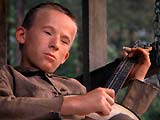
|
||||||
|
# 89. The Godfather (1972) Francis Ford Coppola's award-winning film is part of a lush saga/trilogy that has earned its place in American culture as a modern-day iconic film about violence, power, corruption, family loyalty, and revenge. The Corleone crime "family" in Manhattan in the mid 1940s, is dominated first by wise godfather/patriarch "Don" Vito Corleone (Marlon Brando in a tremendous, award-winning acting portrayal) - the head of one of the five Italian-American "families" that operate a crime syndicate in New York City. In the long, opening scene of the film, Corleone is in his home's dark office, regally and ruthlessly carrying on business during his daughter Connie's (Talia Shire) wedding reception, held in the bright, sunshiny outdoor veranda. It is the custom of the father of the bride to grant favors to all petitioners and those who pay homage. In the masterfully-photographed, underlit office, American justice has failed. Ostensibly, the Don is a gentle, under-stated, restrained, 62 year old aging man, sitting behind his study's desk. His face has a bulldog appearance with padded cheeks, and he speaks slowly with a high-pitched, hoarse, raspy, gutteral mumbling accent. On his lap is a cat whose head he lovingly and gently strokes. Although he moves stiffly, he wields enormous lethal power as he determines the dispensation of justice - who will be punished and who will be favored. He listens to supplicants' requests for extra-legal help and determines how to make offers that people can't refuse. [An unforgettable short sequence in the film is the one of the severed head of prized race horse Khartoum in the silk-sheeted bed of a recalcitrant Hollywood film producer Jack Woltz (John Marley).] |
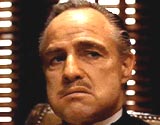 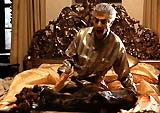
|
||||||
|
# 90. The Exorcist (1973) This controversial film is the sensational, tawdry, shocking horror story about devil possession and the exorcism of the demonic spirits from a young, innocent, twelve year-old Regan MacNeil (Linda Blair). Ghastly expressions of her possession were masterfully created with remarkable special effects to manipulate audiences into feeling dread, nausea, and fright. At first, Regan's bed is racked with violent convulsions. Flopping around on the top of the bed, the young girl frantically calls out: "Make it stop! Make it stop!" Her mother Chris (Ellen Burstyn) throws herself on top of Regan on the wildly bucking bed which bounces up and down on the floor- there is a cacophony of deafeningly loud, grating noises. Soon after, Regan's hysterical despairing screams intensify and "things have gotten worse...they've gotten violent." Regan's upper torso is violently being whipped and thrown back and forth on the bed, battering her body as it slams into the mattress. She screams: "Oh please, Mother, make it stop! It's hurting." Then she is tossed upwards and bounces up and down. Her uncontrollable seizures are accompanied by low gutteral growls, almost animalistic. Her throat below her chin bubbles out. When one of the doctors reaches for Regan on the bed, she slaps him back-handed across the face, knocking him into the door and onto the floor. Her physically-repulsive voice warns: "Keep away! The sow is mine!" She pulls up the front of her nightgown, masturbates by rubbing herself, and in a deep, strange voice, beckons: "F--k me! F--k me!" One of the film's most horrifying scenes is the notorious crucifix-masturbation or stabbing scene. From upstairs in Regan's bedroom, her mother hears grotesque sounds, crashes, and screams. She runs up the stairs towards the door - it opens and she sees 45 rpm records, books, and stuffed animals being hurled at the tightly-closed window. The camera registers the horror on her face as she sees her daughter's sacrilegious self-abuse. In an obscene gesture simulating masturbation or a stabbing, a horribly-disfigured Regan repeatedly thrusts her bloodied hand clutching the crucifix into her vagina under her blood-splattered nightgown, as she bellows obscenities in the Devil's voice: "Let Jesus f--k you, let Jesus f--k you! Let him f--k you!" When Chris grabs her daughter's super-strong arm and tussles with her for control of the offending object. Regan punches her mother with a violent blow, sending her backwards across the bedroom floor. With her telekinetic power, Regan moves a chair against the door to bar everyone's way, and she sends a tall wooden bureau across the floor toward her mother. As a bloody-faced Regan sits on her bed, she spins her head backwards 180 degrees, threatening and taunting in a deep malevolent voice as she imitates the British accent of a recently-murdered friend of Chris': "Do you know what she did? Your c--ting daughter?" In the grossest scene of the film, as Father Karras (Jason Miller) approaches closer, Regan lurches forward on the bed and spews bilious, pea-green soup vomit from her mouth in a single projectile stream directly into his face. The thick green slime sticks to his face and clothing. Vomit also dribbles down onto Regan's nightgown. |
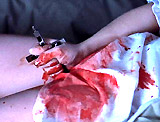  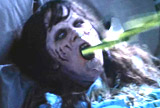
|
||||||
|
# 91. Chinatown (1974) The superb, private eye mystery and modern-day film noir thriller from director Roman Polanski skillfully blends mystery, romance, suspense, and elements of hard boiled detective film noirs. The investigation of a routine story thought to be marital infidelity by a 1930s Los Angeles private detective-hero J. J. (Jake) Gittes (Jack Nicholson) uncovers secrets under many layers, facades, and networks of deception. One night, Jake drives to the Oak Pass Reservoir to further investigate the scene of the discovery of a corpse, and to see whether portions of the city's water supply are being dumped or secretly diverted. After scaling the locked, chain-link fence with a 'No Trespassing' sign, Gittes hears two shots of gunfire - a signal to open the water sluice. Ignorantly believing he is a shooting target, he jumps into a run-off channel for cover. The storm drain immediately fills with a torrent of rushing water, slamming him into a barrier and almost claiming him as the next drowning victim. Then, after climbing back over one fence in his soggy clothes, he is threatened for trespassing by Claude Mulvihill (Roy Jenson), the city's sheriff. Gittes flippantly asks Claude: "Where'd you get the midget?" referring to another hired thug dressed in a beige suit, white shirt, spotted red and white bow-tie and Panama hat. The maniacal, intimidating, knife-wielding hoodlum (director Roman Polanski in a minor cameo role) wants to scare him off the case. Jake gets a warning to stop snooping (nosing) around just before his nostril is viciously cut with a knife:
He sports a bloody-bandaged and stitched nose in the next scene (a symbolic beacon of his trespassing into other people's business) and an unraveling bandage for the rest of the film. [In the film's ending scene set in Chinatown - the only scene in the film which actually takes place there, all the characters converge in a startling and despairing climactic scene.] |
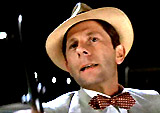 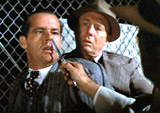  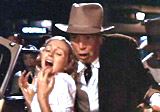 
|
||||||
|
# 92. One Flew Over the Cuckoo's Nest (1975) A disturbing, tragi-comedic film that swept the major Academy Awards in the year of its release - the film succeeded as a tale of a wise-guy hero who rebels against institutional authority and attitudes in a tyrannical mental hospital. An energetic, swaggering, wisecracking, non-conformist, rebellious patient/prisoner Randle Patrick McMurphy (Jack Nicholson) feigns insanity to avoid doing jail time, finding himself in immediate conflict with supervisory Nurse Ratched (Louise Fletcher), head of the locked, security ward of a state mental hospital. In one of the film's many stunning scenes, the patronizing, parental Nurse disallows the patients from watching the second game of the World Series - she refuses to have the usually compliant and spiritless fellow patients/inmates won over to the reasoning of McMurphy and changes the rules of voting to defeat the proposal. Livid with anger, McMurphy wills the game into existence - he pretends to be enjoying the baseball game on television in a contest of wills with the Nurse. He re-creates the play-by-play excitement of the game by the power of his imagination. His excitement proves infectious and he galvanizes the other patients to join him, cheer, and look up at the blank television screen - it reflects the smiles on their faces when a fantasized ballplayer hits a home run. |

|
||||||
|
# 93. Rocky (1976) The 1970s action-packed, crowd-pleasing, feel-good story of the rise of a small-time Philadelphia boxer against insurmountable odds. Rocky Balboa (Sylvester Stallone), a simple-minded bum, is a 30-year-old Philadelphia club fighter who resorts to small bouts, and serves as the strong-arm collections man for a local numbers racket run by a local loan shark. When the unknown Rocky is chosen to be boxing champ Apollo Creed's (Carl Weathers) opponent for the January 1st event, a world heavyweight title fight, it is a once-in-a-lifetime boxing bout opportunity. Rocky's training program begins in earnest under weathered gym manager Mickey's (Burgess Meredith) fight training and management. In the most memorable sequence of the film, a montage, Rocky underwent grueling training from Thanksgiving to New Years by running through the Philadelphia streets, doing one-armed pushups, and pounding hanging slabs of raw meat in a slaughterhouse freezer where his buddy Paulie (Burt Young) worked.
At the end of this workout, one of his last ones, he raced up the steps of the Art Museum, hands triumphantly raised in the air, accompanied by the rousing song, "Gonna Fly Now" (by Bill Conti). Although his first run up the endless steps was exhausting, his last run was effortless.
|
  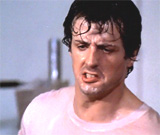  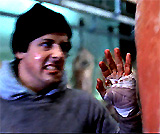 
|
||||||
|
# 94. Taxi Driver (1976) Martin Scorsese's masterpiece depicted one man's descent into insanity, alienation, and cathartic violence within the nauseating, squalid landscape of New York City. Cabbie Travis Bickle (Robert De Niro), an enigmatic, 20th century loner has a disastrous date with a pretty blonde political worker for the Palantine campaign named Betsy (Cybill Shepherd). Projecting his anger, bare-chested Travis has attached guns to himself (first one - and then two shoulder holsters and a third gun from behind) in his squalid apartment. He practices drawing the guns in front of a mirror. Turning more alienated and violent and harnessing his puritanical energy, he manufactures a custom-made fast-draw, gliding mechanism that he attaches to his forearm, and another concealed knife-holder for a horrible-looking combat knife on his ankle. The weapons and other spring-loaded, metal gadgets attached to him are extensions of his body - his gunmanship is astonishing. In the most terrifying, but classic sequence in the film, he glares at himself in the mirror and recites conversations in which he threatens and insistently challenges imaginary enemies, rehearsing his quick-draw with his spring-loaded holster:
|
 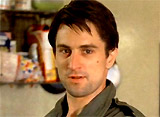 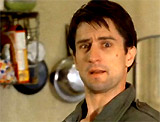
|
||||||
|
# 95. Saturday Night Fever (1977) No other film best captured the disco craze of the 70s generation than this John Badham film and its image of actor/dancer John Travolta. Cocky young Brooklyn paint store clerk Tony Manero (John Travolta), a wanna-be Broadway dancer, escapes each weekend to the local disco dance floor of 2001 Odyssey. In a tight white leisure suit, bodyshirt, tight pants and black platform shoes, the sleek and graceful disco king struts his stuff on a pulsating, colorful dance floor - his arm pointed in the air - to the rockin' music of the Bee Gees. [Seventeen years later, Travolta again showcases his dance talent in Quentin Tarantino's Pulp Fiction (1994). As hitman Vincent Vega, he nervously entertains underworld boss' wife Mia Wallace (Uma Thurman) at a retro 50's style diner/club called Jack Rabbit Slim's - the wait staff is composed of dead 1950s icons like Marilyn Monroe, Buddy Holly, and James Dean. They enter the restaurant's hip-swiveling dance contest, frugging and ponying a marvelous composite of faddish dances from the faded era, including the Batusi from the mid-to-late 60s Batman TV show, to the tune of Chuck Berry's "You Never Can Tell." The dance's trademark action was moving the index and middle finger-spread open in a "V" shape-across the face as to make a mask over the eyes.] |
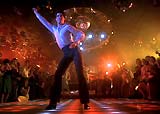 
|
||||||
|
# 96. Apocalypse Now (1979) Francis Ford Coppola's visually brilliant masterpiece contains innumerable scenes of excellence. At the start of the film's most memorable, greatest set of sequences, Willard (Martin Sheen) seeks the captain in charge of the bloody attack on the Viet Cong. He encounters the commanding officer of the Air Cavalry - a hawkish, lunatic, flamboyant Lieutenant Colonel Bill Kilgore (Robert Duvall), wearing a black horse soldier's Stetson cavalry hat (a la George A. Custer) with a cavalry sword emblem, sunglasses, and a yellow dickey. To secure a Vietcong beachhead at a N. Vietnamese village because it is one of the Vietcong's best surfing areas in "Charlie's" territory, Kilgore orders a massive helicopter air attack on an unsuspecting, seemingly innocent, quiet, peaceful Vietnamese village the next dawn after a trumpet cavalry charge is sounded on a bugle. The armada of choppers glide silently through the breaking light like a harmless flock of birds - it is one of the film's most impressive, memorable sequences. The crazed Kilgore has ordered the music: "We'll come in low out of the rising sun, and about a mile out, we'll put on the music...Yeah, use Wagner. Scares the hell out of the slopes. My boys love it." Chef reflexively imitates other soldiers by removing his helmet and sitting on it - to avoid having his "balls blown off." Kilgore commands: "Shall we dance?" as the music is piped out from the swarm of helicopters - the front of his copter is painted with the motto adorned with crossed swords: "Death from Above." The choppers become menacing as rockets and gunfire spew out along with Wagner's Ride of the Valkyries blasting over the helicopter-mounted loudspeakers to scare the enemy. Surfboards are loaded on the side of the command helicopter. Later, after the devastating, pyrotechnic attack, with the jungle leveled and engulfed in flames behind him, Kilgore smells the napalm, squats on the beach, and exclaims in a now-famous line of dialogue:
|
  
|
||||||
|
# 97. The Shining (1980) Stanley Kubrick's homage to the horror genre was illustrated in his adaptation of Stephen King's novel. Aspiring writer Jack Torrance (Jack Nicholson) is hired to be the off-season caretaker with his family of the Overlook Hotel, a snow-bound Colorado resort. The effects of isolation, the hotel's disturbing, murderous history, and other familial pressures lead to the corrupting and possession of Jack's soul. With a crazed, homicidal, ferocious temper, he pursues his wife Wendy (Shelley Duvall) with a long-handled axe to their apartment's front door: "Wendy, I'm home." Both Danny (Danny Lloyd), his young son and Wendy retreat to the bathroom. Danny escapes and slides down a giant drift of snow resting next to their bathroom window, but Wendy is unable to fit through the ice-jammed window's narrow passageway. As Jack stalks her into the bathroom, he lurches after her with a loathsome, macabre sense of humor, envisioning them in a bizarre, tragic-comic fairytale in which he is the 'big bad wolf':
He smashes his way into the bathroom door, with each stroke of the blade jutting through the wood, as his screaming wife watches his progress with her butcher knife poised to strike. He peers through the broken slats with an evil grin and perversely exclaims:
|
  
|
||||||
|
# 98. Raiders of the Lost Ark (1981) A spectacular, cliff-hanger, breathlessly-paced, non-stop action/adventure film of the early 1980s that was an immensely successful summer box-office hit that mimicked the great 1930's adventure serials. The opening sequence which begins under the credits is a hang-on-to-your-seats experience. In 1936, American expedition leader Dr. Indiana "Indy" Jones (Harrison Ford), sporting his signature short, brown leather flight jacket, a brimmed felt fedora, and a bullwhip firmly in his hand is in a South American rainforest jungle making his way to a cave entrance that conceals a temple. Deep inside the cave is an altar where the coveted object of Indy's mission is located - a tiny, gold jeweled figurine or statuette artifact - a disembodied head. At the start of a memorable sequence, Indy reaches the altar where the idol looks both fierce and beautiful. From inside his jacket, he removes a small, canvas drawstring bag filled with sand, bouncing it in his hand to estimate the approximate weight of the idol and rubbing his chin. With tremendous concentration, he twitches his fingers (the guide Satipo twitches his fingers also) and then deftly and smoothly replaces the idol with the sand-filled bag to avoid triggering another booby trap. For a few moments, all seems well, until the pedestal beneath the bag suddenly begins to sink into the altar stone. Indy has miscalculated the weight in the swap, setting off a loud chain reaction of destruction after pilfering the sacred object. The entire sanctuary rumbles and shakes and rocks fall loose from the collapsing walls, as Indy spins and runs through a tiled floor area, setting off a noisy torrent of poisonous darts and arrows. As he hurriedly departs through the perilous cave, he turns toward a loud rumbling noise and sees behind him a huge, thundering boulder, tumbling, roaring and rolling in his direction - perfectly sized to fit the passageway. Indy dashes just ahead of the destructive, crushing boulder, leaping to safety outside the cave, as the giant rock slams into the entrance of the cave, sealing it perfectly, but then faces another frantic chase to his water-plane to escape from natives. |
   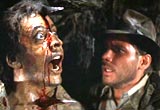   
|
||||||
|
# 99. When Harry Met Sally... (1989) In the justly-famous restaurant-deli scene, two long-time acquaintances grapple with the difficulties of relationships. Commitment-shy Harry Burns (Billy Crystal) describes how he can "just get up out of bed and leave" after sex by any number of fake excuses: "I say I have an early meeting, an early haircut, an early squash game." Blonde, clean-living Sally Albright (Meg Ryan) is affronted by his insensitivity and sexist attitudes: "You know, I am so glad I never got involved with you...You are a human affront to all women. And I am a woman." Harry confidently believes his sexual prowess satisfies his female partners and brings them to orgasm, until Sally explains how "most women, at one time or another, have faked it." Harry doesn't believe that he has been fooled because he can tell the difference between a real and a faked orgasm. Sally looks at Harry seductively, and begins to illustrate, in the middle of the busy restaurant, how easily women can convincingly fake an orgasm. With a loud and long display of groans, gasps, hair rufflings, caresses, table poundings, and ecstatic releases, she yells: "Yes, Yes, YES! YES! YES!" The entire restaurant quiets down and is attentive to her realistic act. When she is finished with her demonstration, she calmly picks up her fork and resumes eating. This is followed by the film's funniest line, delivered by another customer (Estelle Reiner - director Rob Reiner's mother) who tells the waitress, "I'll have what she's having" - referring to the meal ordered by Sally. |
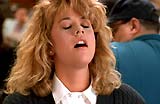 
|
||||||
|
# 100. Schindler's List (1993) Steven Spielberg's unanimously-praised historical epic presents an uncompromising view of the Holocaust. In the midst of a dark, frightening period during World War II, when Jews in Nazi-occupied Krakow were first dispossessed of their businesses and homes, then placed in ghettos and forced labor camps in Plaszow, and finally resettled in concentration camps for execution, one man - Oskar Schindler - an enterprising Nazi German industrialist/opportunist, first exploited Jewish/Polish workers in a successful enamelware factory and eventually rescued more than one thousand of them from certain death. In one of the film's most stunning images, the keys of his accountant/business manager Itzhak Stern's (Ben Kingsley) typewriter are magnified as they crisply rap out names to create a list of the individuals who will be saved from extinction from the Nazi war machine by being bought for employment - they are Schindler's List: Dresner, Wein, Rosner, Poldek Pfefferberg, Mila Pfefferberg, Stagel, Scharf, "all the children," Lewartow, and more. Names and lists are two of the film's major visual motifs. The list grows from four hundred, to six hundred, to eight hundred, to almost 1,100 individuals. When the list nears completion, Stern comments: "The list is an absolute good. The list is life. All around its margins lies the gulf." [Another remarkable sequence: the liquidation of the ghetto and of the Jews in Krakow by Untersturmfuhrer Amon Goeth (Ralph Fiennes) and his commandos, and the final modern day epilogue-segment of Schindler's Jewish survivors lined up on a hillside.] |
|
||||||
1950s (1) | 1950s (2) | 1960s | 1970-90s |
|